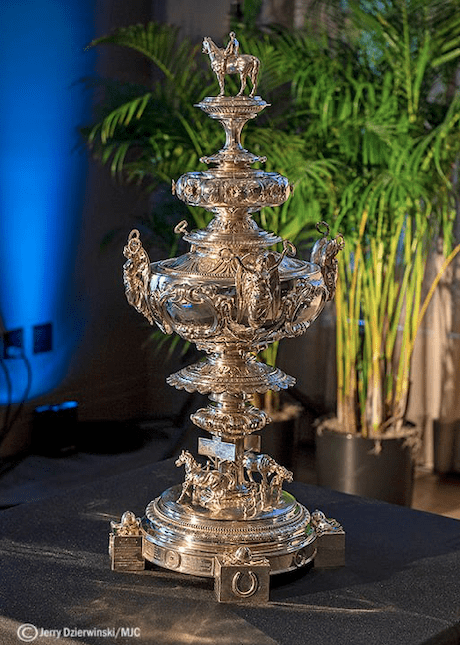
The most valuable trophy in all of sports, The Woodlawn Vase
by Kate Richards
It’s almost impossible to hear the story of the Woodlawn Vase, the 34 “, 29 pound sterling edifice and not feel pride in the perseverance and wildness of American racing history. Our racing storytelling links us to the ancient and the modern, the funny and the poignant, to the constant speculation of ‘what if’ and then to the data-based soothsaying of our handicappers. Our racing history reminds us of a singular owner like a Penny Chenery, a tenacious trainer like RICH STRIKE’s Eric Reed or a woolly fan group called the Chromies. Like a flight simulator, a racing story carries us back to the location or to the emotional impetus of one’s original love for the game. And this, the story of the Woodlawn Vase, told every May in Baltimore, is about the poignancy, a bit of wildness and the legacy of what is considered the most beautiful racing trophy in American racing.
The map of the Woodlawn Vase’s storyline runs back to another track in Louisville, Kentucky and a club known as the Woodlawn Racing Association. Deciding that the club’s signature race demanded a glorious cup for the victor, a club director, Mr. Aitchenson Alexander, commissioned the reknown Tiffany and Company of New York, to create elaborate sterling vessel. The year was 1860 and the rendering of the horse at the top of the Vase was modeled on Kentucky’s finest thoroughbred, the stallion called Lexington. Lexington, originally registered as ‘Darley’ and later nicknamed ‘Blu’ became notable for being regarded as America’s top sire for over 15 years.
The inaugural Woodlawn Association club race of 1861 saw a victory and the Woodlawn Vase awarded to a young filly named Mollie Jackson. She was owned by a Captain Thomas Moore, a local breeder and Southern sympathizer who claimed the prize a second time, in 1862, with his race mare, Idlewind. Here is where the story quickens. Either Captain Moore refused to relinquish the Vase or his realization that Union soldiers could confiscate the silver for bullets, that the stealthy Captain buried the Woodlawn Vase on his Jefferson County farm. Was there gunfire involved or prevented? That volatility has been muted by history.
Ultimately the Woodlawn Racing Club halted their racing activity as owners and race goers were being conscripted. At the same time, a union raid on the Woodburn Farm confiscating fit horses caused his breeder, Dr. Warfield, to ship the totally blind stallion Lexington to Illinois for the remainder of the Civil War. The irony is that one of Lexington’s foals (b.1860) became the favorite horse that carried General Ulysses S. Grant into Appomattox. His name was Cincinnati.
Equal in the rich irony, it was a little later in that Lexington, the stud, returned to Kentucky, and sired Mr. Wilbur Sanford’s colt Preakness (b.1867) that went on to run in and win the Dinner Party Stakes in Baltimore. Two years later, the Maryland Jockey Club, realizing the merits of the Minisi Indian inspired name based on geographical location, renamed the race the Preakness Stakes. Preakness, the horse, retired to Sanford’s farm in Midway, Kentucky to carry on his sire’s, Lexington’s, legacy. Lexington died of natural causes in 1875,was exhumed in 1878 and donated to the Smithsonian, later to be returned to the Kentucky Horse Park.
Post-Civil War, the intact Woodlawn Vase was likewise exhumed and made the winners circle rounds in Louisville, New Jersey and even the Coney Island Jockey Club. Acquired by a Mr. Thomas Clyde of the Maryland Jockey Club, the Woodlawn Vase became the symbol of the Preakness Stakes, the horse
Preakness and his sire, Lexington. A half-sized replica, forged by the Kirk-Steiff Silversmiths is now awarded to the Preakness Stakes victor.
One can view the history and relish the story as there is a commemorative plaque noting the former existence of the Woodlawn Racing Park and its club that stands at the intersection of Westport Road in Louisville, Kentucky. Their trophy enshrined the Preakness and its commemorative model Lexington stamped American racing into the next century. It is a plaque forever linking the stories of stakes races, singular racing personalities and the model of the horse, the illustrious Lexington and his son, Preakness, at the top of the Woodlawn Vase.




